From Curious George to King Kong, monkeys and apes have always been fan favorites. The majestic silverback mountain gorilla and the tiny pygmy marmoset, despite their incredible differences, are all somehow related. Monkeys and apes belong to the taxonomic order Primates. Although primates have many similarities, there are some important distinguishing characteristics between monkeys and apes. The animals classified as apes include the great apes- gorillas, orangutans, chimpanzees, bonobos, and humans– and the lesser apes, gibbons. This article will dissect the 5 main differences that differentiate monkeys vs. apes.

Monkeys come in all different shapes, sizes, and colors
©Ludmila Ruzickova/Shutterstock.com
| Monkeys | Apes | |
| Taxonomy | 200+ species | 20 species |
| Body Size | 4oz- 119lbs | 99lbs- 500lbs |
| Group size | 1- 845 individuals | 1-150 individuals |
| Diet | Frugivorous, carnivorous, herbivorous, omnivorous | Frugivorous, carnivorous, herbivorous, omnivorous |
| Locomotion | Clinging and leaping, quadrupedalism | Quadrupedalism, brachiation, bipedalism |
| Distribution | Africa, Asia, Europe, Central and South America | Africa, Asia, Europe |
Monkeys vs. Apes: 5 Main Differences Between Monkeys and Apes
The main differences that separate monkeys vs. apes are:
- Mobile shoulder joint
- Body size
- Geography
- Presence of tail
- Intelligence
Below we’ll detail each of these differences in order.
#5: Mobile Shoulder Joint
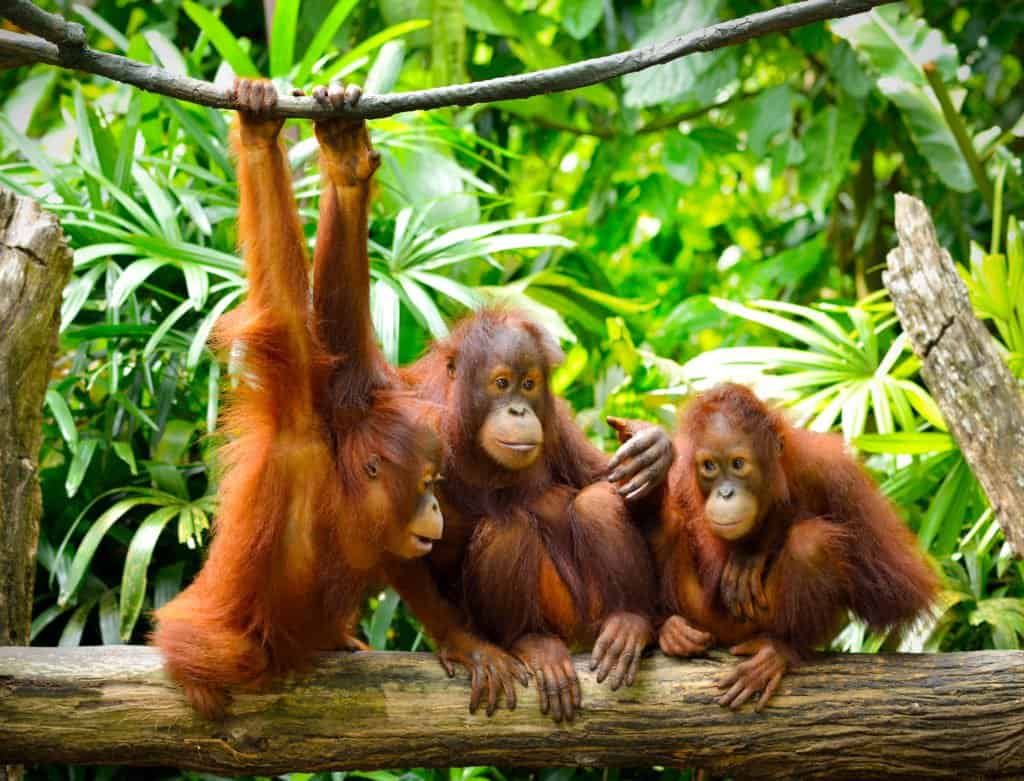
A mobile shoulder joint, long fingers, and short thumbs allow orangutans to easily swing on branches
©tristan tan/Shutterstock.com
Apes have evolved an especially mobile shoulder joint that allows them to swing from branch to branch. This form of movement is called brachiation. The scapula, or shoulder blades, of apes are positioned dorsally, meaning more towards their back rather than on their side. This backwards placement of the shoulder blades allows for less restricted movement in the shoulder joint and enables easier swinging from branches. Although some monkeys can brachiate like apes, most monkeys run across tree branches and leap from tree to tree rather than swinging.
Of the great apes, orangutans spend the most time in the trees rather than on the ground. Their long arms and specialized shoulder joints allow them to efficiently travel in trees. Orangutans also have four long fingers and a uniquely short opposable thumb compared to other apes. This odd hand shape also aids in swinging from branch to branch.
#4: Body Size
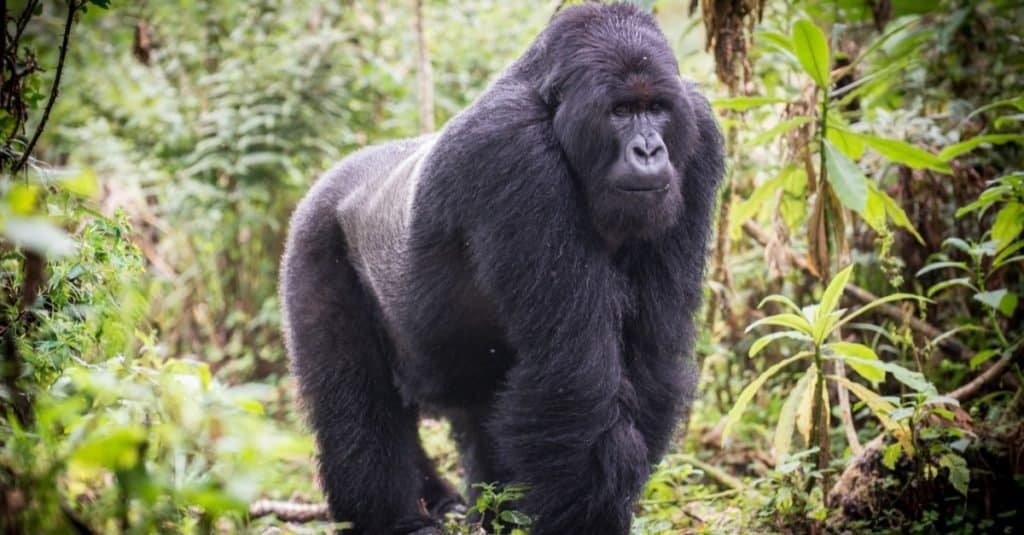
Gorillas are the largest primate in the world
©Jurgen Vogt/Shutterstock.com
In general, apes are much larger than monkeys. Gibbons, the lesser apes, are the exception and are smaller than some large monkey species. The largest of the great apes is the male gorilla which can weigh up to 500 pounds. The largest monkey is the mandrill whose mature male can weigh up to 119 pounds. The smallest great ape is the female bonobo which on average weighs 99 pounds. The smallest monkey, however, is the pygmy marmoset which weighs about 4 ounces.
Both apes and monkeys exhibit sexual dimorphism. This means that males and females of the same species have very different physical traits. Sexual dimorphism is a result of mating competition typically between males and results in many differences including size and coloration. Mandrill males, for example, typically weigh 82 pounds and females weigh up to 32 pounds. Similarly, male gorillas weigh up to 430 pounds and females weigh 220 pounds.
#3: Geography
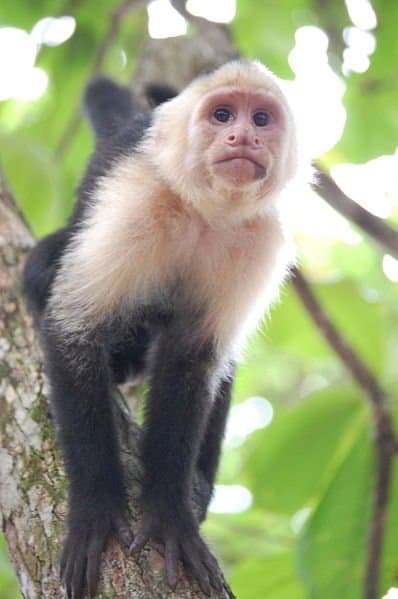
A white-faced capuchin monkey is an example of a New World monkey
©Steven G. Johnson / Creative Commons – Original
Unlike monkeys, there are no apes found in the Americas. For example, Gorillas live in Africa, and orangutans live in Asia. The only exception is humans who currently live around the world. Although humans inhabit the Americas now by means of man-made technology, humans evolved out of Africa and inhabited Africa, Europe, and Asia similar to other apes.
Monkeys are categorized into two groups known as New World monkeys and Old World monkeys. Old World monkeys are found in Africa, Europe, and Asia, and New World monkeys are found in Mexico, Central America, and South America. Apes, like Old World monkeys, are also found in Africa, Europe, and Asia, however many European ape and monkey species have become extinct.
White-faced capuchin monkeys are an example of New World monkeys that live in Central and South America. Tamarins, including the golden lion tamarin, are also New World monkeys that live in South America. An example of an Old World monkey is the mandrill which lives in Africa.
#2: Presence of a Tail
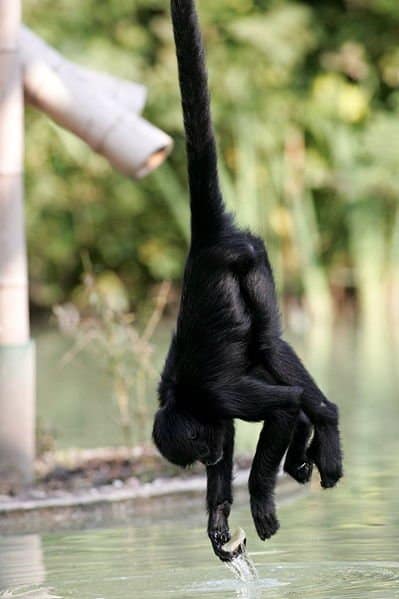
A spider monkey hanging by its tail to collect water
©Patrick Mueller / Creative Commons – Original
Apes, unlike monkeys, do not have tails. Although some monkeys do not have tails either, such as the barbary macaque, no apes have tails and most monkeys do.
Many New World monkeys have a prehensile tail. This means that the tail is able to grasp or hold objects such as a tree branch. Spider monkeys, for example, have a prehensile tail that allows them to be extraordinary climbers. They are able to live in the canopies of forests and use their tail to assist in climbing, swinging, or hanging as they gather fruit.
Most Old World monkeys have tails, but they do not have the same grasping ability. Colobus monkeys, for example, live primarily in tree canopies but they climb without the assistance of a grasping tail. Terrestrial monkey species such as baboons also have tails with no grasping ability.
#1: Intelligence
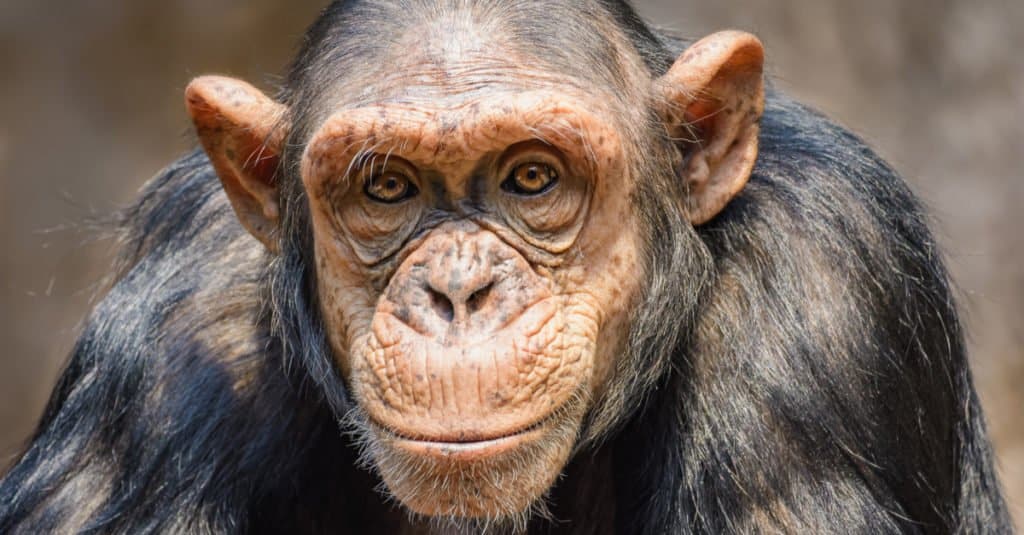
A male chimpanzee
©Thorsten Spoerlein/Shutterstock.com
Arguably the most important and distinctive difference between monkeys and apes is intelligence. Monkeys are considered to have more primitive brains than apes. All primates are incredibly social creatures and amongst mammals, are very intelligent. Intelligence in this context refers to the ability to problem solve, learn, plan, comprehend, and communicate. Behavioral studies done on non-human apes have revealed that they are incredibly intelligent based on their use of tools, social interactions, and ability to learn.
Chimpanzees are documented in the wild and in captivity using a wide variety of tools. They frequently use a “probe” or “fishing stick” to fish ants out of bark or to retrieve honey. Chimpanzees also often use a stone hammer and anvil to crack nuts. A typical chimpanzee in the wild has a toolkit of about 20 different tools and tool use behaviors.
A remarkable example of intelligence in apes is American sign language being taught to gorillas. In 1976, a gorilla named Koko had a vocabulary of over 1,000 ASL signs and could understand 2,000 spoken English words. She was determined to have an IQ level between 70 and 95 on a human scale. A “normal” human IQ on that same scale is 100.
Another example of ape intelligence is memory abilities. In a 2007 study in Kyoto, Japan, chimpanzees competed with humans on a memory test. Jumbled numbers appeared on a touch screen in front of the chimpanzee and in when competition with humans, the chimpanzees consistently completed the memory challenge faster.
Apes in Cinema: Chimp or Human?
Our incredibly intelligent primate cousins will always be a source of interest and charm through works of literature and animation. Thankfully, as we learn more about them and as they gain the respect they deserve, humans will portray them on the big and little screens. Advances in CGI have made it possible to spare animals from the stress of rigid training and performing. Movies such as the recent Planet of the Apes trilogy and television shows like The Umbrella Academy are examples of how apes can be portrayed without harm to animals.
In Summary: The Five Main Differences Between Apes and Monkeys
- #1 Mobile shoulder joint: Apes such as orangutans move through the trees swinging from their arms from limb to limb. Monkeys run and leap from branch to branch.
- #2 Body size: Apes are much larger than monkeys and can weigh up to 500 pounds. The smallest monkey weighs 4 ounces.
- #3. Geography: Monkeys exist all over the world except for North America- while no apes can be found anywhere in the American Continents.
- #4. Presence of tail: Most monkeys have tails – apes don’t.
- #5. Intelligence: Apes are much more intelligent than monkeys – with the ability to learn sign language and to use tools.
Up Next…
- Gorilla Hands vs. Human Hands: What’s the Difference?: Humans may not be as different from our ape cousins as you think! Explore some of the subtle contrasts in this informative article.
- Do Capuchins Make Good Pets? Only on TV: If you have ever wanted a monkey for a pet – read this article first before you embark on the challenge.
- Are Chimpanzees Dangerous?: Inform yourself before your first encounter by learning more about these amazing apes!
The photo featured at the top of this post is ©
Thank you for reading! Have some feedback for us? Contact the AZ Animals editorial team.







